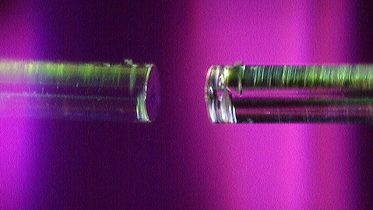The heart of this study is a fiber microcavity. Here, one can see a small concave depression in the surface of an optical fiber. The researchers used a microcavity with two concave mirrors, but this image of a single concave microcavity makes it easier to see the fiber mirror setup.
Credit: Photo by Carlos Saavedra / UW–Madison University of Wisconsin–Madison scientists have developed a new, highly sensitive method to detect and analyze single molecules without using fluorescent labels, potentially transforming research in drug discovery and materials science. Researchers at the University of Wisconsin–Madison have developed the most sensitive method yet for detecting and profiling a single molecule — unlocking a new tool that holds potential for better understanding how the building blocks of matter interact with each other. The new method could have implications for pursuits as varied as drug discovery and the development of advanced materials.

The technical achievement, detailed in a paper published in the journal Nature , marks a significant advance in the burgeoning field of observing individual molecules without the aid of fluorescent labels. While these labels are useful in many applications, they alter molecules in ways that can obscure how they naturally interact with one another. The new label-free method makes the molecules so easy to detect, it is almost as if they had labels.
“We’re very excited about this,” says Randall Goldsmith, a UW–Madison pr.
















